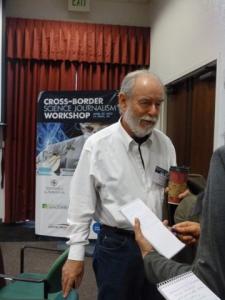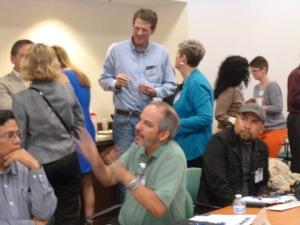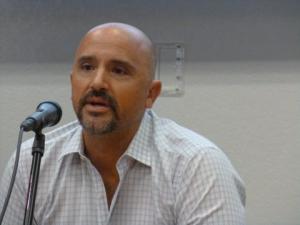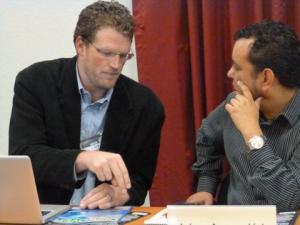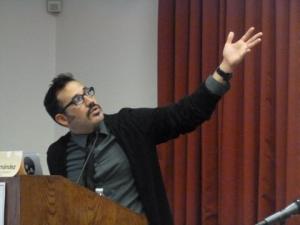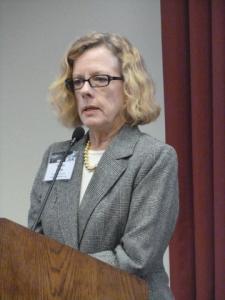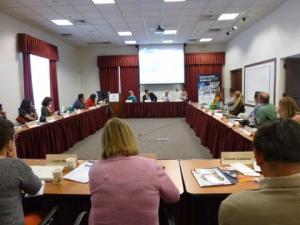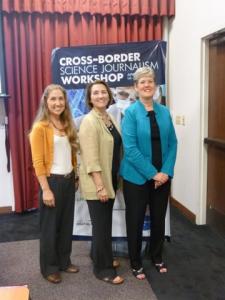By Lynne Friedmann
Science does not stop at the U.S./Mexico border. Yet, regional and national news coverage that chronicles science, technology, the environment, agriculture, fisheries, and public health often overlooks the economic and human impacts south of the border.
In April, a select group of U.S. and Latin American science writers gathered in La Jolla, Calif., for a Cross-Border Science Journalism Workshop with the goals of:
- sharing tools, resources, and contacts to improve cross-border science reporting
- developing professional skills for effective cross-border reporting
- increasing awareness of cross-border issues and markets for resulting stories.
Today young researchers do not have the same level of contact between both sides of the border that Ezcurra enjoyed early in his career. This due to tightened travel restrictions at the border in the wake of 9/11 together with increasing wariness of U.S. students to take graduate courses in Mexico because of fear of narcotics trafficking violence. This is to the detriment of science, according to Ezcurra.
“Borders are physical,” he said. “Ecosystems connect on both sides.”
Despite a relative small research community (18,000 scientists in Mexico, compared to 1.3 million in the United States), Mexico boasts impressive output and impact in such areas as astrophysics, microbiology, and molecular biology.
Two things hamper getting the word out about science in Mexico, according to Estrella Burgos, editor-in-chief of ¿Como vez? magazine.“There are few PIOs at research institutions in Mexico,” said Burgos. “And, science journalists in Mexico need to be better connected with each other via networks.”
Panelists also report a need for better training south of the border so that journalists are empowered to perform their work independently and with a skeptic’s eye in order to question research findings and their applications.
“Mexican society is scared of scientists, viewing them as having too much power,” said Arturo Barba, who, in 2010, launched Mexico’s first science and technology news website (Sapiens Laboratorio de Ideas) and is now press office director of the Ministry of Science, Technology, and Innovation of Mexico City.
Veteran TV news reporter Sergio Vicke recently became an independent documentary producer and writer. It’s a risky career move in Mexico, but one motivated by his desire to bring major social and environmental issues and solutions to the fore.“Climate change is the story of our times,” he said. “People (in Mexico) want to be inspired and take care of their environment,” but are unaware of how others around the world are tackling the problem.
When Bay Area freelance writer Erik Vance moved to Mexico City two years ago in support of his wife’s career, he harbored doubts about how he would continue as a science writer. He need not have worried.
Finding a wealth of world-class researchers and unreported stories, his career has soared with articles ranging from Mexican scientists developing the first updated reptile antivenoms in 60 years (Scientific American) to the struggle to save sharks from extinction in Mexico water (cover story Discover).By the way, Vance does not speak Spanish. His advice to other writers: “Don’t be intimidated by going to Mexico.”
The key, according to Vance, is to partner with Mexican reporters, photographer, and videographers. A case in point is a collaboration between Vance and photographer Dominic Bracco II that resulted in both a Harper’s Magazine story on the dismal future of the global fishery and a companion short documentary After the Fish Are Gone (funded by the Pulitzer Center on Crisis Reporting).
Other notable speakers on the program: Susan White, executive editor of InsideClimate News, whose reporters had one week earlier received the 2013 Pulitzer Prize for national reporting. Also, a hold-on-to-your-seat discussion and demonstration of mobile reporting, infographics, and data visualization by Robert Hernandez, visual journalist and adjunct professor, USC Annenberg School for Communication and Journalism. Videos of all the workshop presentations can be found at bit.ly/ZEI4Ns.Outcomes of the workshop include:
- A “multiplier effect” with Mexican journalists taking back what they learned to share with colleagues.
- Plans for more bi-national outreach via the San Diego Press Club to counterparts in Tijuana.
- Workshop participants remaining in touch via a closed Facebook page.
- Knight Digital Media Center offering discounts on its online courses to workshop participants.
- Discussion of a follow-on workshop in Mexico City.
As a result of the workshop, Vargas-Parada is working in collaboration with Erik Vance on a story they first discussed while in San Diego, as well as working on an assignment from Estrella Burgos. Vargas-Parada’s network now includes workshop participant Lizzie Wade (a former intern at Science who is now living in Mexico City), and workshop co-organizer Genevive Bjorn, with whom she shares numerous interests.
“The Cross-Border Science Journalism Workshop was a sorely needed opportunity for those of us on the northern side of the border to learn from our counterparts down south,” said Tiffany Fox, public information representative, the Qualcomm Institute, UC San Diego. “The panel of high-caliber talks put into stark contrast the similarities and the differences between the U.S. approach to scientific research and that of Mexico, and how national policy, access to sources, and journalistic mores affect reporting of scientific news.” Fox also found the workshop to be a valuable networking opportunity. She arranged three tours of her institute for workshop participants in the weeks that followed.“As scientific collaboration becomes global, our reporting of it must as well,” Fox said. “This workshop provided the practical tools — as well as the inspiration — to widen our circle of influence and begin thinking of national borders, as they pertain to science journalism, as decidedly irrelevant.”
The Cross-Border Science Journalism Workshop was held at the nonprofit Institute of the Americas, located on the University of California, San Diego campus. Primary financial support came from an NASW Idea Grant with additional support from the United States Consulates (Tijuana and Juarez, Mexico), San Diego Press Club, San Diego Science Writers Association, Knight Digital Media Center, and San Diego Zoo Global.
Lynne Friedmann is editor of ScienceWriters.
